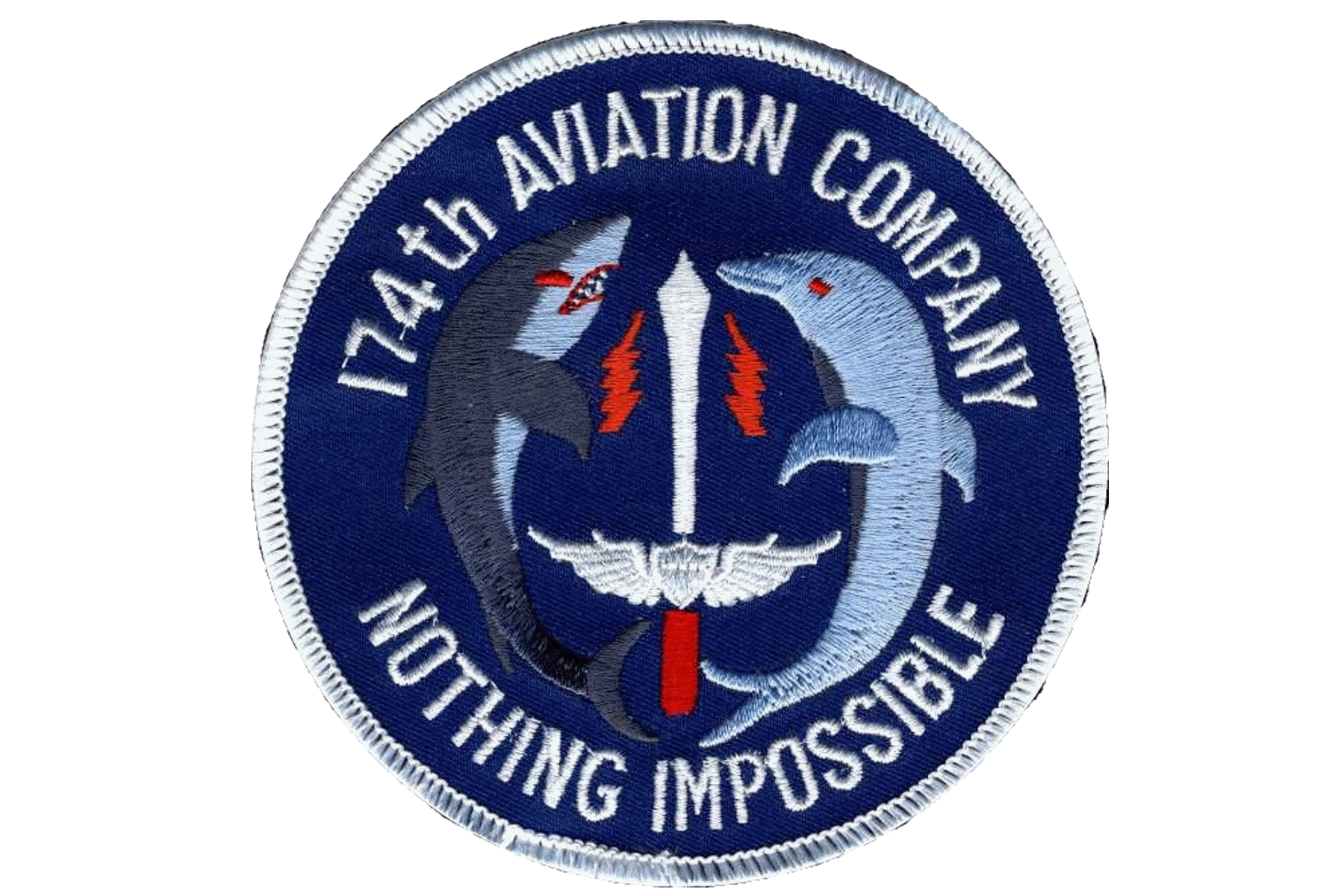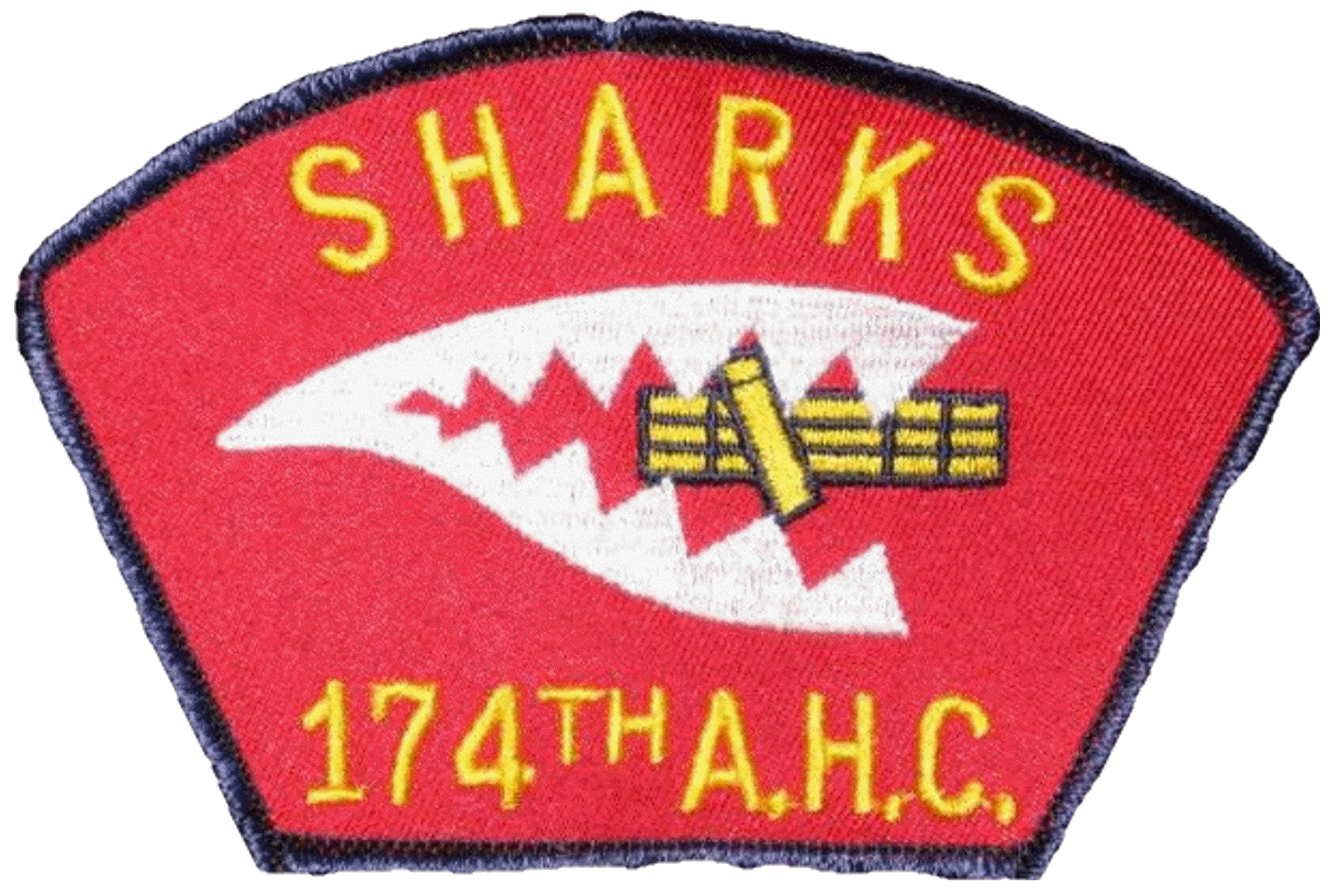174th Assault
Helicopter Company
DOLPHINS & SHARKS
The Shootdown of CPT Peterson and his Crew
Southern Cross (Newspaper) Article
April 16, 1971
Saga of 4 Who Crash-Landed in Laos
By: SGT Matt Gryta
By: SGT Matt Gryta
QUANG TRI, (23rd Inf. Div. IO) -- "I broke the ship to the right and pulled in pitch to get more power
and speed and, as I did that, my rotor pin [RPM] just slowed down, and I knew we were going down,"
Captain Donald A. Peterson recalled.
"The next thing I remember, the ship was on its side in a heavily-wooded area on the slope of the
hill, and I remember thinking, 'Got to get out of here, maybe there's a fire.' I grabbed my M-16 and
crawled out of the ship and saw the ship was intact, and my crew was in good shape."
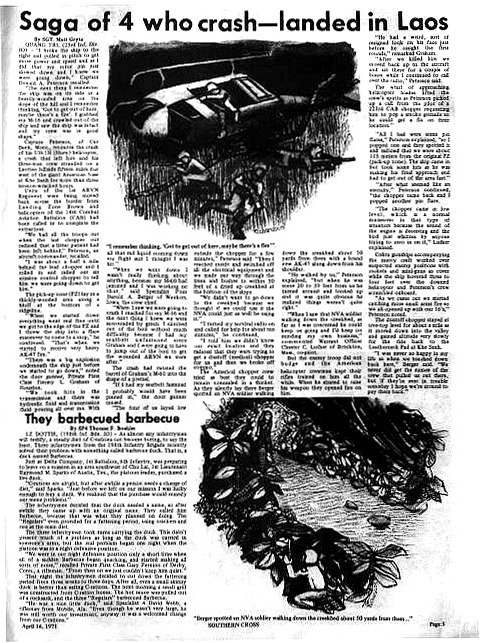 Captain Peterson, of Cut Bank, Mont., recounts the crash of his UH-1H (Huey) helicopter, a crash
that left him and his three-man crew stranded on a Laotian hillside fifteen miles due west of the
giant American base at Khe Sanh for more than three tension-wracked hours.
Captain Peterson, of Cut Bank, Mont., recounts the crash of his UH-1H (Huey) helicopter, a crash
that left him and his three-man crew stranded on a Laotian hillside fifteen miles due west of the
giant American base at Khe Sanh for more than three tension-wracked hours.
Units of the 1st ARVN Regiment were being moved back across the border from Landing Zone
Brown and helicopters of the 14th Combat Aviation Battalion (CAB) had been called in to compete
the extraction.
"We had all the troops out when the last chopper out radioed that a litter patient had been left
behind," Peterson, an aircraft commander, recalled.
"I was about a half a mile behind the lead chopper, and I rolled in and called our air mission control
chopper to tell him we were going down to get him."
The pick-up zone (PZ) lay in a thickly-wooded area along a bluff at the bottom of a ridgeline.
"When we started down, everything went real fine until we got to the edge of the PZ and I threw the
ship into a flare maneuver to come to a stop," he continued. "That's when we started to receive
very
heavy AK-47 fire."
"There was a big explosion underneath the ship just before we started to go down," noted the door
gunner, Private First Class Jimmy L. Graham of Houston.
"We took hits in the transmission and there was hydraulic fluid and transmission fluid pouring all
over me. With all the red liquid running down my flight suit, I thought I was hit."
"When we went down I wasn't really thinking about anything, because my M-60 had jammed and I
was working on that," said Specialist Four Darold A. Berger of Waukon, Iowa, the crew chief.
"When I saw we were going to crash, I reached for my M-16 and the next thing I knew, we were
surrounded by green. I climbed out of the bird without much difficulty because I had my seatbelt
unfastened since Graham and I were going to have to jump out of the bird to get the wounded
ARVN we were after."
The crash had twisted the barrel of Graham's M-60 into the shape of a pretzel.
"If I had my seatbelt fastened, I probably would have been pinned in," the door gunner mused.
"The four of us layed low outside the chopper for a few minutes," Peterson said. "Then I reached
inside and switched off all the electrical equipment and we made our way through the trees and
bushes to within 50 feet of a dried up creekbed at the bottom of the slope.
"We didn't want to go down to the creekbed because we thought if we could use it, the NVA could
just as well be using it."
"I turned my survival radio on and called for help for about ten minutes," he continued.
"I told him we didn't know our exact location and they radioed that they were trying to get a dustoff
(medical) chopper for us, and then we broke off commo."
The Americal chopper crew tried as best they could to remain concealed in a thicket. As they silently
lay there, Berger spotted an NVA soldier walking down the creekbed about 50 yards from them with
a brand new AK-47 slung down from his shoulder.
"He walked by us," Peterson explained, "but when he was some 20 to 30 feet from us, he turned
around and looked up, and it was quite obvious he realized things weren't quite right."
"When I saw that NVA soldier walking down the creekbed, as far as I was concerned, he could keep
on going and I'd keep on minding my own business," commented Warrant Officer Chester C. Luther
of Brockton, Mass., co-pilot.
But the enemy troop did not budge, and the American helicopter crewmen kept their rifles trained on
him all the while. When he started to raise his weapon, they opened fire on him.
"He had a weird, sort of resigned look on his face just before he caught the first rounds," remarked
Graham.
"After we killed him, we moved back up to the aircraft and sat there for a couple of hours while I
continued to call over the radio," Peterson said.
The whirl of approaching helicopter blades lifted the crew's spirits as Peterson picked up a call from
the pilot of a 223rd CAB chopper requesting him to pop a smoke grenade so he could get a fix on
their location."
"All I had were some pin flares," Peterson explained, "so I popped one and they spotted it and
radioed that we were about 115 meters from the original PZ (pick-up zone). The ship came in and
took some hits as he was making his final approach, and had to get out of the area fast."
"After what seemed like an eternity," Peterson continued, "the chopper came back and I popped
another pin flare."
"The chopper came in low level, which is a normal maneuver in that type of situation because the
sound of the engine is deceiving and the bird just whizzes by anyone trying to zero in on it," Luther
explained.
Cobra gunships accompanying the mercy craft worked over suspected enemy positions with
rockets and mini-guns as cover while the ship hovered three to four feet over the downed helicopter
and Peterson's crew scrambled onboard.
"As we came out, we started catching more small arms fire, so we all opened up with our 16's."
Peterson noted.
The dustoff chopper stayed at tree-top level for about a mile as it moved down into the valley, and
gained altitude very slowly for the ride back to the Leatherneck Pad at Khe Sanh.
"I was never so happy in my life as when we touched down back here," Berger said. "We never
did get the names of the crew that pulled us out there, but if they're ever in trouble someday, I hope
we're around to pay them back."
*Excerpts from email correspondence between Door Gunner Jimmy "Wolfman"Graham and Assistant Webmaster (5/29/04):
Graham says, "It's funny how I had blocked some of this out...until I heard the cockpit tapes on the site. All at once it came flooding back. I remember hearing those radio calls like it was yesterday. I can see the main rotor stop in mid-air, but I may have been in fast forward at that second in time. I was only with the unit for a few months unit the accident and was eventually medevaced home. It was a crash. Not a hard landing.
1Lt Chuck Luther was grazed pretty bad in the lip by a round. Another burst went up the back of his seat and hit the back of his helmet, dug a inch wide white slot from bottom to top and went out our windshield. Berger sprained his ankle climbing out of the bird. Actually, he did it by accidently stepping on my face (smile). He thought I was dead. I had been hit three times in the upper chest by AK47 rounds and I was covered in red transmission fluid. AK rounds had gone up the wall behind me and seized the trans. The chicken plate saved my life. It stopped the rounds. Thanks to the makers of that piece of armour.
It turned out that my back was broken when we hit.
I'm a half inch shorter today thanks that "hard landing". Hah! I have a compression fracture of the
lumbar spine. Capt.
Peterson was the only one to escape injury, except maybe getting the s..t scared out of him.
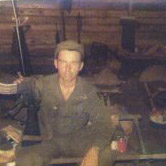
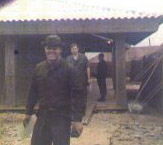
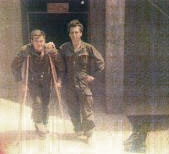
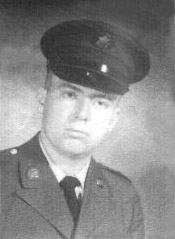
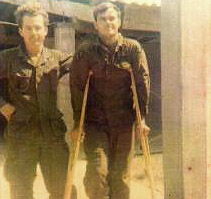
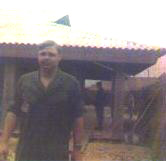
The above photo descriptions (the photos aren't the best, but they've survived 33 years and a fire) that apply are left to right: Me in my hootch, Quang Tri: I made the M16 banana clip with bicycle chain links! The next photo on the right- that would be Cpt. Peterson and Lt. Luther in background. The next photo is of me and Berger (left) with spained ankle. Then my "Mug Shot"...then again me (left) and Berger (right)... and the last photo would be of Chuck Luther.
![]() Click here to see
a 1988 reunion photo of both Don Peterson and Chick Luther.
Click here to see
a 1988 reunion photo of both Don Peterson and Chick Luther.
![]() Return to top of: 1971 page.
Return to top of: 1971 page.
![]() Return to top of: Home Page.
Return to top of: Home Page.
